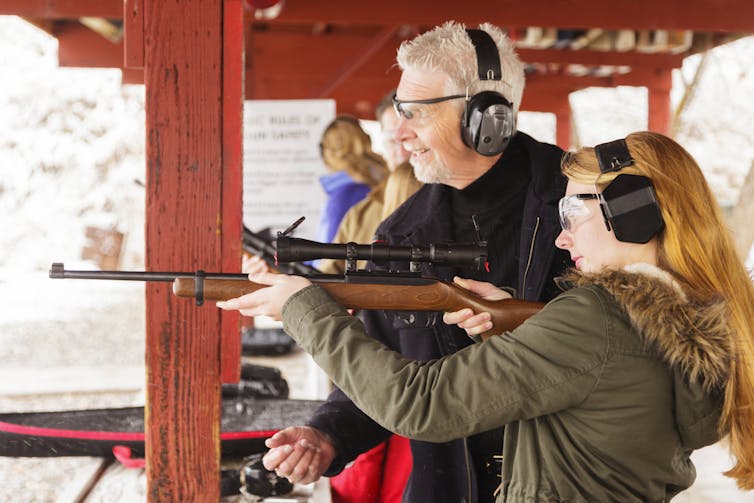
The rationale behind the coalition government’s proposed reform of New Zealand’s gun laws sounds reasonable on the face of it. Responsible gun owners, shooting ranges and clubs deserve a sensible legal framework and a viable financial footing.
But the Arms (Shooting Clubs, Shooting Ranges, and Other Matters) Amendment Bill, currently before the justice select committee, arguably goes about it the wrong way.
In particular, reducing compliance costs for clubs and ranges will not automatically increase memberships or make such organisations more financially viable.
However, making club membership compulsory for gun owners would.
Comparable jurisdictions such as Australia – and New South Wales in particular – use specialised club memberships and attendance at mandatory events as evidence of licence applicants having a “genuine reason” to possess firearms.
The role of clubs and ranges
Whatever its eventual shape, the new legislation will affect many people. As of mid-2024, there were just over 232,000 licensed owners in New Zealand, down from more than 240,000 just a couple of years ago.
There were 1,184 shooting ranges and 396 shooting clubs, of which 303 were non-pistol clubs. Many of these have strong historical, social and cultural foundations, and deliver significant benefits to members, including building skills, confidence and safety awareness.
They are also often run by volunteers and operate on limited budgets. Making them commercially viable is a sensible part of an overall gun safety strategy.
But only an estimated 20,000–40,000 people are affiliated with shooting clubs. Compulsory membership only applies to those with legal endorsements to possess pistols, with participation in 12 club shooting activities per year required.
Non-pistol owners who want a licence are required to pass a three-and-a-half-hour safety course. Whether this is sufficient to cover the fundamental safety considerations is questionable.
There are no obligatory followup courses or a practical live-firing shooting component. By comparison, a prospective gun owner in Japan must attend mandatory all-day classes and pass written and shooting-range tests with an accuracy of at least 95%.

Convincing the public
A little lateral thinking might help square the circle. Making membership of clubs and ranges mandatory for most, and introducing practical components to the licensing and renewal system, would drive up member numbers and income.
As well, facilitating the creation of new clubs – inclusive, specialised, geographically well placed, attractive to a younger generation – would help grow a responsible gun ownership culture.
But for the public to support such initiatives, they will need to be convinced safety is being improved. The fact the terrorist behind the 2019 Christchurch atrocity trained at an established rifle club does not help.
At the other end of the scale, a catalogue of 267 improvement notices issued to operators of clubs and ranges for not meeting prescribed standards has also not inspired confidence.
Changes to the Arms Act made after the Christchurch attacks aimed to tilt the balance more towards public safety. The reforms affected licensing, the prohibition of the some types of firearms, and oversight of clubs and ranges.
Clubs were required to have formal management and improved governance structures. The Firearms Safety Authority/Te Tari Pūreke was responsible for certification, stricter enforcement, inspections and compliance. New national standards, such as the Police Shooting Range Manual, all helped.
Unanswered questions
The government, and particularly the Associate Minister of Justice (Firearms) Nicole McKee, need to explain how watering down of any of these rules – especially around reduced inspections or uniform national standards – will improve public safety.
Five questions stand out.
What are the safeguards to prevent people training in firearms use if they present a threat to public safety? Since 2021, those with firearms prohibition orders against them have been banned from membership of a shooting club or attending any shooting range. But only 30 such orders (eight of which were to gang members) had been issued in the first 15 months of the law taking effect.
Should the same rule to apply to others who don’t meet the prohibition threshold, but have still had licences revoked, or to those deemed unfit (such as gang members or extremists)?
Should the owners or managers of clubs and ranges be obliged to report worrying behaviour to the authorities? The Security Intelligence Service’s guide for identifying signs of violent extremism could be useful here.
Should only registered firearms be allowed to be used at clubs and ranges?
And what obligations should be placed on clubs and ranges to help reduce self-harm, the biggest firearms risk in New Zealand. By building awareness of mental health warning signs, such education and guidance could help gun communities protect vulnerable members.
Law change offers an opportunity to improve gun safety and education. As things stand, however, reform risks reducing public safety while failing to secure the future of clubs and ranges.
Alexander Gillespie is a recipient of a Borrin Foundation Justice Fellowship to research comparative best practice in the regulation of firearms. He is also a member of the Ministerial Arms Advisory Group. The views expressed here are his own and not to be attributed to either of these organisations. He has submitted on this subject to the select committee examining reform of part 6 of the Arms Act.
This article was originally published on The Conversation. Read the original article.







